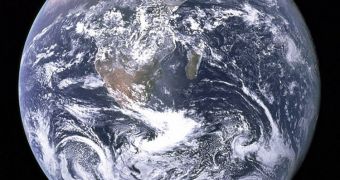According to a paper presented at the 2012 European Planetary Science Congress today, September 25, there is a high probability (under certain scenarios and conditions) that the seeds of life were brought to Earth aboard meteorites, or other pieces of debris originating on other worlds.
Over the past few years, important volumes of data have emerged that suggest life did not originate on our planet, but rather was brought here on space rocks, in the form of organic molecules. It could be that these seeds found an appropriate environment to develop once they arrived.
The same holds true for Earth's waters, which many now believe was brought here aboard comets. The largest volume of water must have been delivered to Earth during the Late Heavy Bombardment, a period when numerous comets, asteroids and meteorites impacted the inner planets of the solar system.
Microorganisms, or at least the building blocks required to create them, may have hitched a ride on these space rocks, embedded inside tiny cracks. Recent studies have demonstrated that lifeforms can endure for prolonged periods in space.
The new study was conducted by experts at the Princeton University, the University of Arizona and the Centro de Astrobiología (CAB), in Spain. Details of the work were published in the latest issue of the esteemed journal Astrobiology.
It's also possible that life spread from Earth to other planets in the solar system, maybe even beyond, through the same mechanisms. Bacteria-carrying rocks may have been ejected from its surface during a collision, and then spent millions of years flying around before landing on another world.
Researchers have also found that it's possible for star systems to exchange rocks as well. Previously, statistical data showed that chances of this happening were 1 in a million. The new study indicates that 12 out of every 10,000 rocks ejected from a star system could be captured by its neighbor.
“Our work says the opposite of most previous work. It says that lithopanspermia might have been very likely, and it may be the first paper to demonstrate that. If this mechanism is true, it has implications for life in the Universe as a whole. This could have happened anywhere,” says Edward Belbruno.
The expert, a mathematician and visiting research collaborator in Princeton's Department of Astrophysical Sciences, was the one who developed these so-called principles of weak transfer. He is the first author of the Astrobiology paper.
“The conclusion from our work is that the weak transfer mechanism makes lithopanspermia a viable hypothesis because it would have allowed large quantities of solid material to be exchanged between planetary systems, and involves timescales that could potentially allow the survival of microorganisms embedded in large boulders,” says CAB astronomer and paper coauthor, Amaya Moro-Martín.

 14 DAY TRIAL //
14 DAY TRIAL //